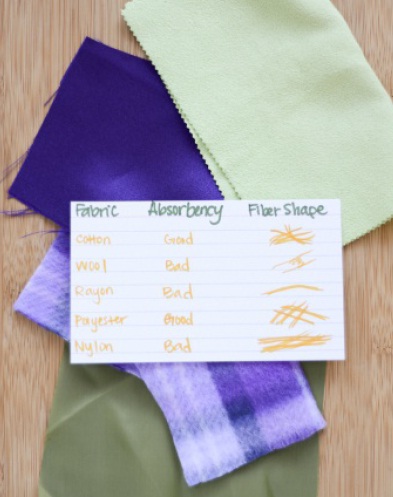





Published on Feb 13, 2025
The objective: We are surrounded by textiles everyday, from the clothes we wear to the sheets that keep us warm at night to the umbrellas we use when it rains. Though there are many kinds of fabrics, their most suitable applications depends largely on properties such as absorbency. Absorbency is how much liquid the fabric can take inside and hold in its fibers. Fabric is actually made up of a network of very thin threads and in these threads are fibers twisted together. The shape of the fiber is very important to determine how absorbent the fabric will be.
How does the shape and strucure of the fibers in a fabric affect its absorbency?
Students are familiar with the importance of shape in everyday, visible life. For example, fine point sharpies are used for detail work while chisel edge is used for poster print; sleek and sporty cars are driven for speed while heavy-duty pickup trucks are used for construction and transporting. Unfortunately, students often fail to carry this concept over to their microscopic studies of biology and chemistry. Shape and structure, however, is pivotal to the function and properties of even small molecules and proteins, and it is this microscopic structure that determines the macroscopic properties that we can see and experience.
You’ve heard it before. Cotton Kills! Cotton Kills! Why does it kill? Because it absorbs lots of water—up to 27 times its weight—which rapidly wicks away body heat and can lead to potentially life-threatening hypothermia in cool or cold conditions. But what is it about cotton that allows it to absorb so much water in the first place?
There are two primary reasons: structure and chemistry. First, the easier-to-explain structure. A cotton fiber is like a tiny tube formed of six different concentric layers (see diagram). As individual cotton fibers grow on the plant, the inside of the “tube” is filled with living cells. Once the fiber matures and the cotton boll opens up to reveal its puffy white contents, these cells dry up and the fiber partially collapses, leaving behind a hollow bean-shaped canal, or “lumen” (see the ultra-magnified image below). This empty space holds lots of water.
Lumens also help provide cotton with its exceptional “wicking” ability, drawing water up along the fibers through capillary action—like sucking on a straw. (Synthetic fibers like nylon are solid, with no internal spaces within the fiber to contain water. Whatever water is absorbed is contained on the fibers’ surfaces.) Lumens also radically increase the surface area of the fiber for water to interact with, which leads to the chemistry part of this.
Processed cotton fibers are 99 percent cellulose. Cellulose is a polymer composed of a long chain of connected glucose molecules that each contains three hyrodoxol groups with slight negative charges. Water, as you may remember from high school chemistry, has a slightly positive charge (the oxygen atom draws in the two hydrogen atoms’ electrons). The upshot is that water molecules are attracted to—and bond with (via “hydrogen bonds”)—the zillions of hydroxol groups in cotton. This, coupled with the vast amount of space contained within and between the fibers, provides cotton with its tremendous water-absorbing properties.
100% cotton fabric -- a “fat quarter” from the fabric
store will work
100% polyester fabric
100% rayon fabric
100% wool fabric
100% nylon fabric
Water
Microscope
Pen and paper for notes

1. Observe the fibers of the cotton fabric sample under a microscope. Note the shape of its fibers and how the threads are woven/knit together.
2. Pour half a regular-siz ed drinking glass of water on a flat table.
3. While wet, press the cotton fabric sample onto the water. Make sure it is soaked and try to get all the water up from the table in one attempt.
4 . Go back to the microscope and observe the fibers again. What do you see now that is different from before? What is happening to the fibers?
5. Repeat steps 1-4 for the rest of your fabric samples.
6. Record your results.
http://www.epa.gov/acidrain/measure/ph.html
http://www.chem4 kids.com/files/react_acidbase.html
http://www.onlinesciencemall.com/Shop/Control/Product/fp/SFV/30852/vpid/1829806/vpcsid/0/rid/126318
Grahame W. Gould, New Methods of Food Preservation.